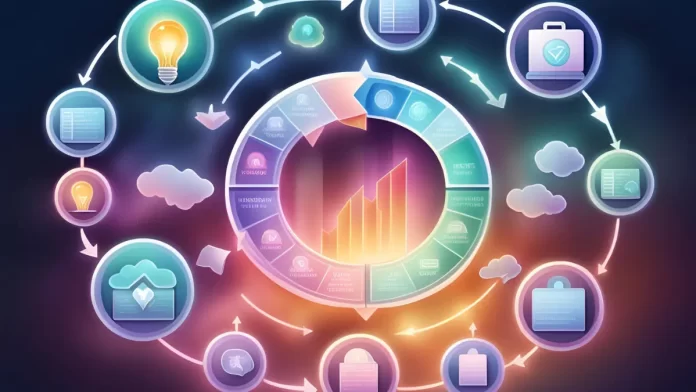Implementing an ERP system can transform business operations, but success requires more than selecting the right software. A well-structured approach is essential, and this is where the ERP life cycle plays a crucial role. As a step-by-step framework, it guides businesses through planning, implementation, and continuous optimization to ensure a smooth transition and maximize return on investment.
Without a clear ERP life cycle, companies may face delays, cost overruns, and inefficiencies that hinder rather than improve operations. On the other hand, a well-executed ERP implementation enhances productivity, streamlines processes, and strengthens decision-making across the organization.
This article explores the essential phases of the ERP life cycle, providing insights into how each stage contributes to a seamless and effective implementation. Continue reading to learn how to make your ERP investment a strategic advantage for long term business success.
Key Takeaways
|
Table of Content
Content Lists

What is an ERP Life Cycle?
The ERP life cycle is a structured process that outlines the key stages involved in selecting, implementing, and maintaining an Enterprise Resource Planning system.
It serves as a roadmap that helps businesses navigate the complexities of ERP adoption, ensuring a smooth transition and long term success.
A clear understanding of this life cycle is essential to ensure that the chosen ERP software aligns with business goals, streamlines operations, and enhances overall efficiency.
The Importance of ERP in Business
Implementing an ERP system can revolutionize business operations by integrating all functions into a unified database, ensuring greater data consistency. This technology also provides valuable insights that empower managers to make quick informed decisions.
More than just improving operational efficiency, ERP systems serve a crucial function in strategic decision-making. With real time data access, businesses can respond swiftly to market changes and capitalize on new opportunities.
For companies in Malaysia, where adaptability and agility are essential in a competitive market, ERP systems can be the key to sustained growth and success.
Key Phases Life Cycle of ERP
To successfully navigate the ERP life cycle, it’s essential to understand the key phases involved.
Each phase plays a crucial role in ensuring that your ERP software implementation aligns with your business goals and operates smoothly. The journey begins with the critical step:
Phase 1: Selecting the right ERP package
Choosing the right ERP system is a critical decision, as it must align with your business’s unique needs. Key features such as accounting, inventory, and finance modules should be carefully evaluated to ensure they support your operational goals.
Understanding ERP selection criteria including scalability, integration capabilities, and industry-specific functionality, helps businesses in Malaysia make informed choices.
Phase 2: Strategic planning
This phase involves defining the project scope, establishing realistic timelines, and allocating resources efficiently. Developing a detailed project roadmap allows businesses to anticipate potential challenges and ensures a smooth transition.
Phase 3: System design and customization
Adapting the ERP system to fit your organization’s specific workflows is crucial. This phase focuses on configuring and customizing the software to enhance functionality and user experience. A well-designed ERP system improves efficiency by addressing industry-specific requirements and streamlining core processes.
Phase 4: Development and integration
During the development stage, the ERP system is built according to the design specifications. Various modules—such as human resources, sales, and supply chain management—are integrated to create a unified platform that supports all aspects of business operations.
Phase 5: Rigorous testing
Thorough testing is essential before deployment to ensure the ERP system operates as expected. Functional testing verifies that each module works correctly, integration testing ensures seamless communication between modules, and user acceptance testing confirms that the system meets business requirements.
Phase 6: Deployment and data migration
Deploying the ERP system requires careful execution to minimize disruptions. This stage includes migrating business data, configuring user access, and officially going live. A well-planned deployment strategy ensures a smooth transition and maintains operational continuity.
Phase 7: Employee training
Comprehensive training is vital to the successful adoption of the ERP system. Employees must be proficient in using the new software to maximize its benefits. Providing structured training programs ensures staff can navigate the system effectively.
Phase 8: Ongoing support and maintenance
Post-implementation support is essential for addressing technical issues and ensuring the ERP system continues to perform optimally. Regular updates, troubleshooting, and user assistance help businesses maximize the system’s lifespan and adapt to evolving operational needs.

Risks of Not Implementing ERP
Companies that postpone or neglect the adoption of ERP systems risk hindering their growth and losing their competitive advantage. An ERP system centralizes and streamlines various business processes, and without it, organizations may face operational inefficiencies that can create long-term setbacks.
Here are the risk you might face if you dont implement ERP:
- Disconnected systems: Relying on multiple, unintegrated systems creates data silos, making it difficult to access and analyze information across departments. This lack of cohesion leads to inconsistent data, hindering effective decision-making and strategic planning.
- Operational inefficiencies: Without an ERP system, businesses often rely on manual processes and outdated software, leading to errors, delays, and decreased productivity. These inefficiencies not only slow down operations and increase costs but also impact the overall ERP return on investment, making it harder for companies to achieve long-term growth and efficiency.
- Limited business insights: A lack of centralized data reduces real-time visibility into operations, making it harder to track performance, manage inventory, and respond to market changes. This lack of oversight can lead to missed opportunities and difficulty in adapting to business demands.
These risks highlight the necessity of implementing an ERP system. Without ERP, businesses may struggle to keep up with competitors who leverage this technology to stay ahead.
Seamless ERP Life Cycle Implementation with HashMicro

Deploying an ERP system can be a challenging and time-intensive process, but HashMicro simplifies this transition significantly. Our ERP solution is designed to optimize every stage of the implementation life cycle, ensuring a seamless and efficient integration for your business.
With a strong focus on user-friendly functionality and comprehensive support, HashMicro makes ERP adoption more accessible and less overwhelming. How HashMicro Simplifies ERP Implementation:
- Swift deployment: HashMicro’s ERP system accelerates implementation, minimizing the transition from planning to full operation. Its modular structure allows businesses to adopt the system in phases, ensuring a seamless alignment with specific requirements and timelines.
- Dedicated customer support: We offer comprehensive assistance throughout the implementation process, addressing any concerns promptly. This hands-on support is especially crucial during key stages like development and testing, helping to prevent delays and errors.
- Intuitive user interface: HashMicro’s modern and user-friendly interface simplifies both system navigation and employee training. Its intuitive design shortens the learning curve, enabling teams to adapt quickly and focus on driving business growth.
- Effortless integration: Our ERP system integrates smoothly with existing tools and workflows, reducing disruptions during deployment. This seamless connectivity ensures business continuity with minimal downtime.
- Continuous enhancements: Post-implementation, HashMicro provides ongoing support and regular system updates to maintain peak performance. This proactive approach helps businesses stay competitive and operate efficiently in a constantly evolving market.
Conclusion
Understanding and implementing the ERP life cycle is essential for any business seeking to improve efficiency and stay competitive in the market. HashMicro’s ERP software offers a user-friendly interface and flexible architecture, making it easier for Malaysian businesses to integrate and optimize their operations at every level.
By simplifying complex processes and providing real-time insights into business performance, HashMicro’s ERP software ensures that your investment delivers measurable benefits.
Sign up for a free demo today and explore how HashMicro’s ERP software can streamline your operations and enhance decision making.

FAQ ERP Life Cycle
-
What is the ERP process?
Enterprise resource planning (ERP) is a software system that helps organizations streamline their core business processes including finance, HR, manufacturing, supply chain, sales, and procurement with a unified view of activity and provides a single source of truth.
-
What are the 3 common types of ERP?
The three most common types of ERP are on-premises, cloud-based, and hybrid ERP. An on-premises ERP system is run on-location on a company’s servers, while cloud-based ERP operates on a third-party, remote server.
-
What is ERP format?
An ERP software system is a set of integrated applications or modules for managing a company’s core business processes. ERP modules integrate into one complete system and share a common database to streamline processes and information across the enterprise. Businesses can expand the scope of their ERP as they grow.




































